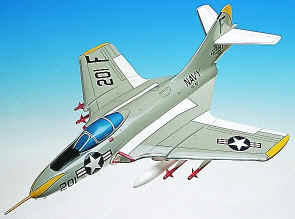|
|
|
 |
Grumann
F9F-2/5 (F-9) Panther, Cougar |
 |
The plans originally drawn in 1946 by the
Grumman Aircraft Corporation for a night fighter were refined in
favor of a day fighter utilizing a 5,000 lb thrust Pratt &
Whitney engine manufactured under patent from Rolls Royce of
Britain. On the basis of initial test flight data by Grumman
pilots, production orders from the Navy were contracted before
completion of their tests. Designated as the F9F
"Panther", the 500 mph fighter proved ideal for
carrier operations in that it was capable of taking off in 800
feet (430 feet in a 30 knot wind) and could land at speeds
between 85 and 90 mph.
First delivered in 1949, the
"Panther" soon outfitted most Navy squadrons as well
as 3 Marine Corps squadrons. During joint exercises involving
Navy, Marine and Air Force units, a Marine squadron with its
"Panthers" were credited with the theoretical
destruction of ninety F-84 "Thunderjets" with a loss
of only nine F9F's.
During the Korean war, the
"Panther" proved to be a pace setter in establishing
several firsts for Navy carrier-based jet operations: first to
participate in combat; first to shoot down enemy aircraft
including a Yak-9 and the famous Mig-15; and, first
air-to-ground bombing attack. The "Panther" was also
deployed in a reconnaissance role by the Navy and as
fighter-bombers by land-based Marine Corps squadrons. On the
home front it was used by the Navy's flight demonstration team,
the "Blue Angels", in 1950 and 1952 through 1954.
The "Panther" underwent a number of
design changes during its service life including a fuselage
extension and a 35-degree swept-wing conversion to be
rechristened the "Cougar".
|
|

|
F9F-5 Panther
Standard Series. 1/32nd scale. 13.65" wingspan
x 13.5" long.
No. AFN7D-SP. Only $129.95 |
 |
F9F-8
Cougar
Standard Series. 1/32nd scale.
13.5" wingspan x 17.65" long
No. AFN7D-SC. Only $139.95
|
|
|
